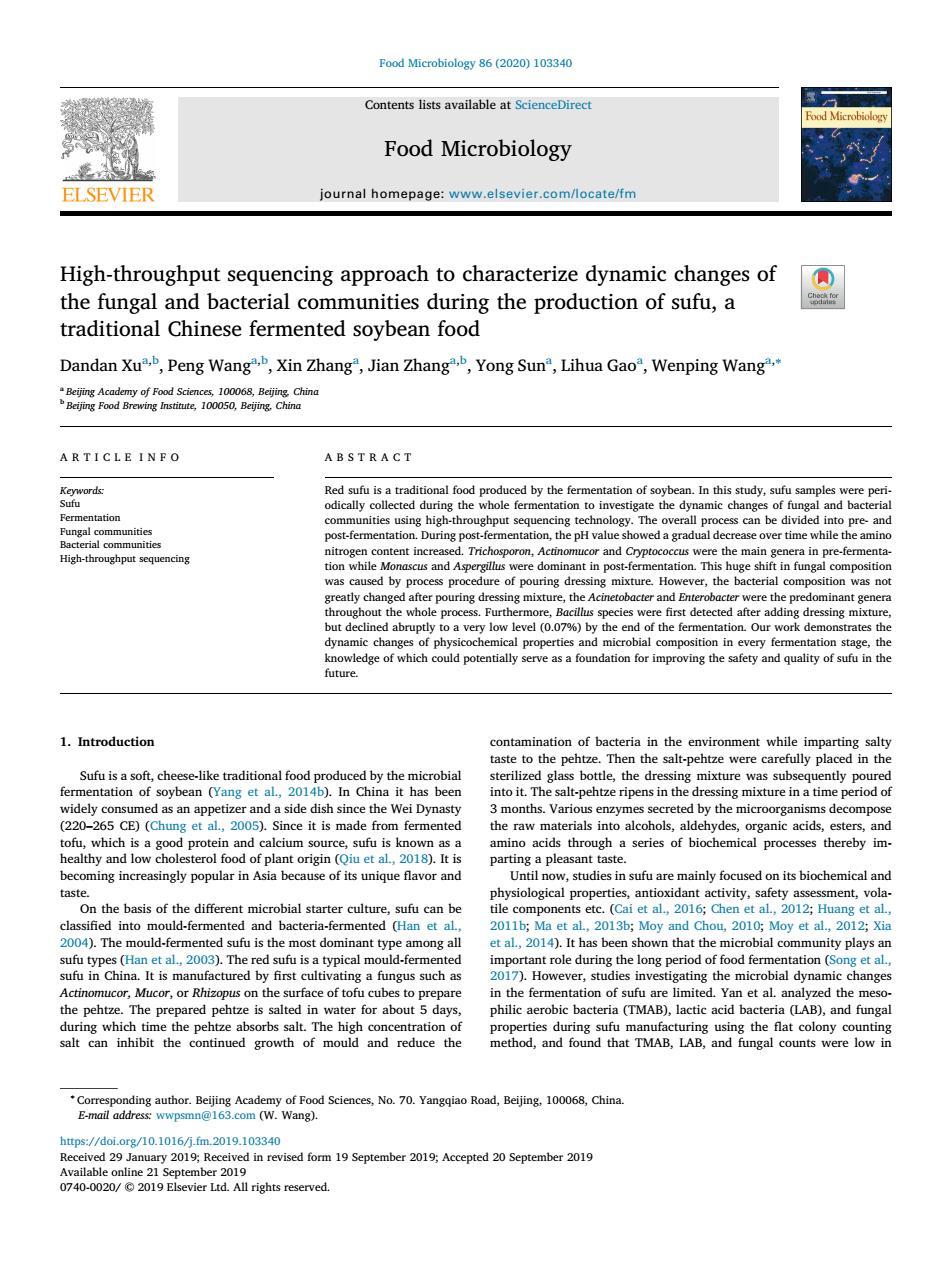正在加载图片...

Fod (0)130 Contents lists available at Food Microbiology ELSEVIER journal homepage:www.elsevier.com/locate/fm High-throughput sequencing approach to characterize dynamic changes of the fungal and bacterial communities during the production of sufu,a traditional Chinese fermented soybean food Dandan Xu,Peng Wang,Xin Zhang",Jian Zhang,Yong Sun',Lihua Gao",Wenping Wang" ARTICLE INFO ABSTRACT Red sufu is a traditional foo tation of sovbean.In this study.sufu s pe tation ties using high-t logy.The caused by process proced re of po ingdree& hou the w Furth dressing m 1.Introduction Ssttisasowtcaceclkctmdtitiomalfoodpiotcedtrhcnicrobie ths.Vario CotCTeted by the microorganisms de ompos tofu. protei and calcium sufu is k知 as a amino acids through a series of biochemical processes thereby im as on the basis of the different microbial starter cuture,sufu can be peoogcprocrtiCaniniontactaeyo2memttol ermented (Han et a 013b;Moy and .2010 oy et al.. an 2003).Th oleduring the long peri on han Mucor,or R us on the n the 6 tion of suf et al.ar ed the co ties sufu the aA the and reduce the method,and ungal cou Contents lists available at ScienceDirect Food Microbiology journal homepage: www.elsevier.com/locate/fm High-throughput sequencing approach to characterize dynamic changes of the fungal and bacterial communities during the production of sufu, a traditional Chinese fermented soybean food Dandan Xua,b , Peng Wanga,b , Xin Zhanga , Jian Zhanga,b , Yong Suna , Lihua Gaoa , Wenping Wanga,∗ a Beijing Academy of Food Sciences, 100068, Beijing, China b Beijing Food Brewing Institute, 100050, Beijing, China ARTICLE INFO Keywords: Sufu Fermentation Fungal communities Bacterial communities High-throughput sequencing ABSTRACT Red sufu is a traditional food produced by the fermentation of soybean. In this study, sufu samples were periodically collected during the whole fermentation to investigate the dynamic changes of fungal and bacterial communities using high-throughput sequencing technology. The overall process can be divided into pre- and post-fermentation. During post-fermentation, the pH value showed a gradual decrease over time while the amino nitrogen content increased. Trichosporon, Actinomucor and Cryptococcus were the main genera in pre-fermentation while Monascus and Aspergillus were dominant in post-fermentation. This huge shift in fungal composition was caused by process procedure of pouring dressing mixture. However, the bacterial composition was not greatly changed after pouring dressing mixture, the Acinetobacter and Enterobacter were the predominant genera throughout the whole process. Furthermore, Bacillus species were first detected after adding dressing mixture, but declined abruptly to a very low level (0.07%) by the end of the fermentation. Our work demonstrates the dynamic changes of physicochemical properties and microbial composition in every fermentation stage, the knowledge of which could potentially serve as a foundation for improving the safety and quality of sufu in the future. 1. Introduction Sufu is a soft, cheese-like traditional food produced by the microbial fermentation of soybean (Yang et al., 2014b). In China it has been widely consumed as an appetizer and a side dish since the Wei Dynasty (220–265 CE) (Chung et al., 2005). Since it is made from fermented tofu, which is a good protein and calcium source, sufu is known as a healthy and low cholesterol food of plant origin (Qiu et al., 2018). It is becoming increasingly popular in Asia because of its unique flavor and taste. On the basis of the different microbial starter culture, sufu can be classified into mould-fermented and bacteria-fermented (Han et al., 2004). The mould-fermented sufu is the most dominant type among all sufu types (Han et al., 2003). The red sufu is a typical mould-fermented sufu in China. It is manufactured by first cultivating a fungus such as Actinomucor, Mucor, or Rhizopus on the surface of tofu cubes to prepare the pehtze. The prepared pehtze is salted in water for about 5 days, during which time the pehtze absorbs salt. The high concentration of salt can inhibit the continued growth of mould and reduce the contamination of bacteria in the environment while imparting salty taste to the pehtze. Then the salt-pehtze were carefully placed in the sterilized glass bottle, the dressing mixture was subsequently poured into it. The salt-pehtze ripens in the dressing mixture in a time period of 3 months. Various enzymes secreted by the microorganisms decompose the raw materials into alcohols, aldehydes, organic acids, esters, and amino acids through a series of biochemical processes thereby imparting a pleasant taste. Until now, studies in sufu are mainly focused on its biochemical and physiological properties, antioxidant activity, safety assessment, volatile components etc. (Cai et al., 2016; Chen et al., 2012; Huang et al., 2011b; Ma et al., 2013b; Moy and Chou, 2010; Moy et al., 2012; Xia et al., 2014). It has been shown that the microbial community plays an important role during the long period of food fermentation (Song et al., 2017). However, studies investigating the microbial dynamic changes in the fermentation of sufu are limited. Yan et al. analyzed the mesophilic aerobic bacteria (TMAB), lactic acid bacteria (LAB), and fungal properties during sufu manufacturing using the flat colony counting method, and found that TMAB, LAB, and fungal counts were low in https://doi.org/10.1016/j.fm.2019.103340 Received 29 January 2019; Received in revised form 19 September 2019; Accepted 20 September 2019 ∗ Corresponding author. Beijing Academy of Food Sciences, No. 70. Yangqiao Road, Beijing, 100068, China. E-mail address: wwpsmn@163.com (W. Wang). Food Microbiology 86 (2020) 103340 Available online 21 September 2019 0740-0020/ © 2019 Elsevier Ltd. All rights reserved. T